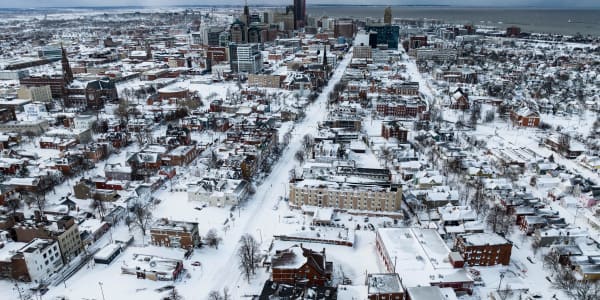Building roads to prosperity
If you've ever been late for an appointment because you got caught in a traffic jam, you know the importance of good infrastructure. Companies searching for America's Top States for Business want a place where they can get their people — and their products — where they need to be, on time. That means not just good roads and bridges but airports, seaports and rail lines. Good infrastructure also means sound utilities.
We measure all of those things and more in our Infrastructure category, worth 350 out of 2,500 points. You can see our complete study and learn about our methodology here. Only a handful of states have the infrastructure to be Top States. These are the top 10.
10. Florida
The Sunshine State is not only a major population center in its own right; it is the gateway to Latin America, and it is well-equipped for the role. The Florida Seaports Council says the state's 15 ports generate $96 billion a year in economic activity. Florida is also the second busiest state (after California) for air travel, with 5.8 million takeoffs and landings at Florida airports last year. Roads and bridges are in good shape.
2016 Infrastructure score: 211 out of 350 points
Deficient bridges: 16 percent
Average commute to work: 26.1 minutes
Major airports: Miami International; Orlando International
20-year water system needs: $16.5 billion
9. Missouri
Strategically positioned in the nation's midsection, the home of Kansas City Southern is a major rail link. Some 457 million tons of freight made its way through Missouri in 2014, the fourth-largest total in the United States. And with two major inland ports, in Kansas City and St. Louis, and two international airports, Missouri is a vital part of the nation's transportation network.
2016 Infrastructure score: 214 out of 350 points
Deficient bridges: 26 percent
Average commute to work: 23.1 minutes
Major airports: Lambert-St.Louis International; Kansas City International
20-year water system needs: $8.5 billion
8. Kansas
Kansas is literally in the heart of the country, so if you're traveling coast to coast, chances are at some point you will be passing through here. More than 367 million tons of freight traveled on Kansas railways in 2014. Bridges are in relatively good shape, and commuting times are more than manageable.
2016 Infrastructure score: 216 out of 350 points
Deficient bridges: 16 percent
Average commute to work: 19.1 minutes
Major airport: Wichita Mid-Continent
20-year water system needs: $4.2 billion
7. Ohio
With ports on Lake Erie to the north, Ohio River to the south and miles of railways and highways in between, Ohio is a crucial transportation hub. The state exported more than $41 billion worth of goods in 2012, the most recent statistic available. The 241-mile Ohio Turnpike, completed in 1955, carries roughly 50 million vehicles per year.
2016 Infrastructure score: 218 out of 350 points
Deficient bridges: 23 percent
Average commute to work: 23.1 minutes
Major airport: Cleveland Hopkins International
20-year water system needs: $12.2 billion
6. North Dakota
While the shale-oil boom that supercharged North Dakota's economy has cooled now, it allowed the state to begin redeveloping its infrastructure in a big way. Water utilities are in sound shape, and commuting times are lightning-fast. Roads and bridges are in better shape than most states.
2016 Infrastructure score: 219 out of 350 points
Deficient bridges: 21 percent
Average commute to work: 17.1 minutes
Major airport: Hector International (Fargo)
20-year water system needs: $449.7 million
5. Minnesota
The 2007 collapse of the Interstate 35W bridge over the Mississippi River in downtown Minneapolis killed 13 people and called attention to the nationwide infrastructure crisis. Minnesota took the incident to heart. Within a year the state replaced the structure with the state-of-the-art St. Anthony Falls Bridge, and today Minnesota has the lowest percentage of deficient bridges in the nation.
2016 Infrastructure score: 224 out of 350 points
Deficient bridges: 9 percent
Average commute to work: 23 minutes
Major airport: Minneapolis-St. Paul International
20-year water system needs: $7.4 billion
4. Georgia
It might not be readily apparent while you are fighting Atlanta traffic, but Georgia's roads and bridges are among the best in the nation. And that's just the start. The Port of Savannah boasts the largest single container terminal in North America. Hartsfield-Jackson Atlanta International Airport is the busiest in the world. When it comes to infrastructure, this state means business.
2016 Infrastructure score: 231 out of 350 points
Deficient bridges: 16 percent
Average commute to work: 27.2 minutes
Major airport: Hartsfield-Jackson Atlanta International
20-year water system needs: $9.3billion
2. (Tie) Texas
When they say that everything is big in Texas, they might be referring to the fact that no state ships more commodities based on dollar value. Or that it is one of the busiest states for air traffic, with more than 4.5 million takeoffs and landings last year. Or that the state carried more than 400 million tons of freight by rail in 2014. Texas does have some big issues with its public utilities, and commuters often encounter some big traffic jams. But this state has clearly come to play.
2016 Infrastructure score: 239 out of 350 points
Deficient bridges: 19 percent
Average commute to work: 25.2 minutes
Major airports: Dallas-Fort Worth International; George Bush Intercontinental (Houston)
20-year water system needs: $33.9 billion
2. (Tie) Tennessee
In the home of the Tennessee Valley Authority, public investment in infrastructure is a heritage dating back to the Authority's founding in 1933. Twenty years ago the Tennessee legislature decided to take on the state's infrastructure needs head-on, empowering a state commission to identify infrastructure needs and develop plans to meet them. Today, Tennessee's infrastructure performs well across all our metrics.
2016 Infrastructure score: 239 out of 350 points
Deficient bridges: 18 percent
Average commute to work: 24.4 minutes
Major airports: Memphis International; Nashville International
20-year water system needs: $2.7 billion
1. Indiana
Indiana calls itself the Crossroads of America, and the state lives up to the name with the best roads in the country. But the crossroads are not just highways. The state's extensive rail network carried more than 300 million tons of freight in 2014. Indiana is home to three major ports. Burns Harbor, on Lake Michigan, is Indiana's gateway to the world. The ports at Jeffersonville and Mount Vernon on the Ohio River transport coal, agricultural products and auto parts to the Gulf of Mexico and beyond.
2016 Infrastructure score: 241 out of 350 points
Deficient bridges: 21 percent
Average commute to work: 23.3 minutes
Major airport: Indianapolis International
20-year water system needs: $6.5 billion






